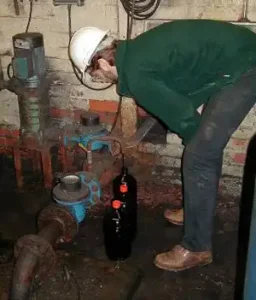Pesticides include herbicides, insecticides, fungicides and growth regulators. They can get into groundwater both from leaching from agricultural land, and from non-approved use, poor practices or illegal operations.
Pesticide problems can be challenging to study because of the large number of different compounds used, each with unique fate and transport properties, and the low concentrations permitted in abstracted water groundwater under drinking water regulations (Water Supply (Water Quality) Regulations 2010).

Sampling. BGS © UKRI.
BGS studies of pesticides in groundwater
BGS groundwater research has built on a series of studies in the 1990s that focused on understanding pesticide transport and attenuation in groundwater (such as Foster et al., 1991).
Studies have included:
- field-scale soil sorption and degradation studies for the herbicide diuron and its metabolites (Gooddy et al., 2002)
- a regional study of diuron and its metabolites in the Chalk aquifer (Lapworth and Gooddy, 2006)
- a large, commissioned project for a water utility to understand the extent of pollution in groundwater in the Permo–Triassic sandstone aquifer involving regional and temporal surveys of groundwater, site investigation and complementary modelling studies of borehole capture zones for a range of pesticides (Lapworth et al., 2006; Gooddy et al, 2005; Stuart et al., 2006)
- natural attenuation of the enantiomeric fractions of the herbicide mecoprop downgradient of a landfill in the Lincolnshire Limestone; the study revealed subtle differences in mecoprop degradation in different redox environments within the aquifer (Williams et al., 2003)
- investigation of the significance of colloids in the transport of pesticides in UK aquifers (Lapworth et al., 2005; Gooddy et al., 2007)
- development of novel techniques to understand transport processes
References
Browse NORA for our recent publications relating to research into pesticides.
Chilton, P J, Stuart, M E, Gooddy, D C, Williams, R J, and Johnson, A C. 2005. Pesticide fate and behaviour in the UK Chalk aquifer, and implications for groundwater quality. Quarterly Journal of Engineering and Geology and Hydrogeology, Vol. 38, 65–81. DOI: https://doi.org/10.1144/1470-9236/04-014
Foster, S S D, and Chilton, P J. 1991. Mechanisms of groundwater pollution by pesticides. Journal of the Institution of Water and Environmental Management, Vol. 5, 196–193. DOI: https://doi.org/10.1111/j.1747-6593.1991.tb00606.x
Gooddy, D C, Mathias, S A, Harrison, I, Lapworth, D J, and Kim, A W. The significance of colloids in the transport of pesticides through Chalk. Science of The Total Environment, Vol. 385(1–3), 262–271. DOI: https://doi.org/10.1016/j.scitotenv.2007.06.043
Gooddy, D C, Stuart, M E, Lapworth, D J, Chilton, P J, Bishop, S, Cachandt, G, Knapp, M, and Pearson, T. 2005. Pesticide pollution of the Triassic Sandstone aquifer of South Yorkshire. Quarterly Journal of Engineering Geology and Hydrogeology, Vol. 38, 53–63.
Gooddy, D C, Chilton, P J, and Harrison, I. 2002. A field study to assess the degradation and transport of diuron and its metabolites in a calcareous soil. Science of the Total Environment. Vol. 297(1–3), 67–83. DOI: https://doi.org/10.1016/S0048-9697(02)00079-7
Lapworth, D J, and Gooddy, D C. 2006. Source and persistence of pesticides in a semi-confined chalk aquifer of south-east England. Environmental Pollution, Vol. 144(3), 1031–1044. DOI: https://doi.org/10.1016/j.envpol.2005.12.055
Lapworth, D J, Gooddy, D C, Stuart, M E, Chilton, P J, Cachandt, G, Knapp, M, and Bishop, S. 2006. Pesticides in groundwater: some observations on temporal and spatial trends. Water and Environment Journal, Vol. 20(2), 55–64. DOI: https://doi.org/10.1111/j.1747-6593.2005.00007.x
Lapworth, D J, Gooddy, D, Harrison, I, Kim, A, and Vane, C H. 2005. Colloidal phase transport of pesticides: a review with special reference to major UK aquifers. British Geological Survey Report IR/05/131. (Nottingham, UK: British Geological Survey.)
Stuart, M E, Gooddy, D C, Hughes, A G, and Jackson, C R. 2006. A field and modelling study to determine pesticide occurrence in a public water supply in northern England, UK. Groundwater Monitoring and Remediation, Vol. 26(4), 128–136. DOI: https://doi.org/10.1111/j.1745-6592.2006.00113.x
Williams, G M, Harrison, I, Carlick, C A, and Crowley, O. 2003. Changes in enantiomeric fraction as evidence of natural attenuation of mecoprop in a limestone aquifer. Journal of Contaminant Hydrology, Vol. 64(3–4), 253–267. DOI: https://doi.org/10.1016/S0169-7722(02)00206-1
